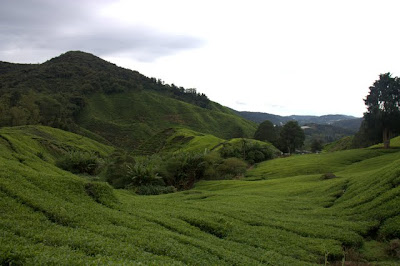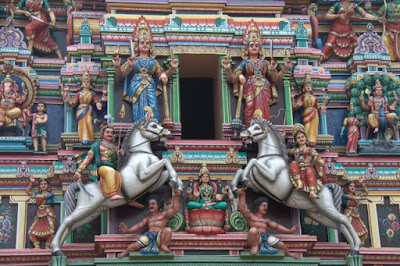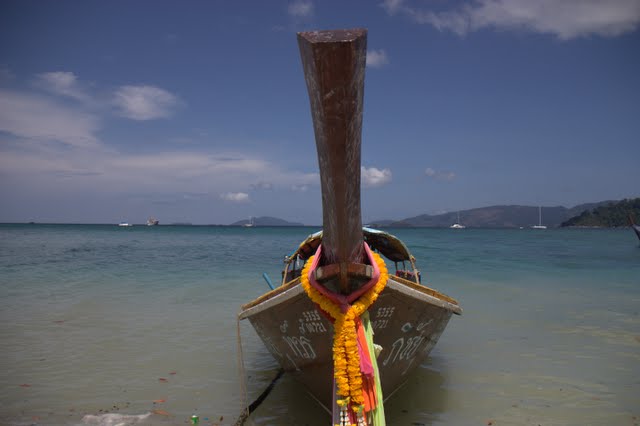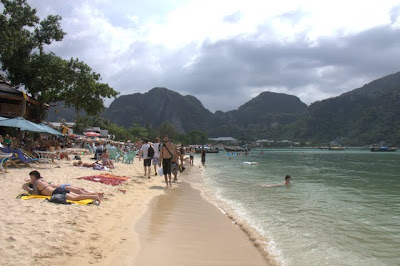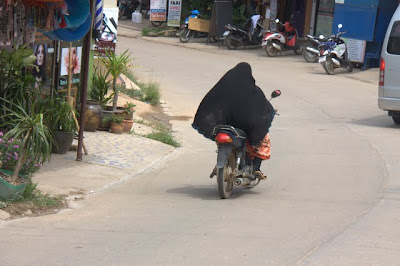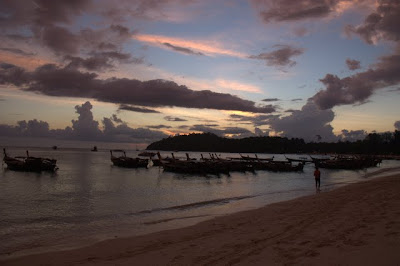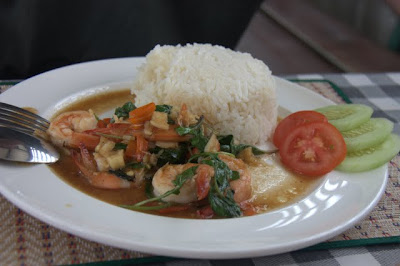Our Grand Finale: Kauai
A stopover on the island of Kauai on our way home from New Zealand at pretty much the same cost in flights? You don’t have to ask me twice. And so we found ourselves back in Hawaii for the second time in our lives, something I would never have predicted during our first visit. Back when we visited Oahu, the Big Island and Maui on our honeymoon, Hawaii was pretty much the most exotic place we had ever been. We spent much of our honeymoon soaking in the differences. Now, as the grand finale to our trip around the world and the first time we were back in the United States in over a year, we couldn’t help but notice the similarities. We were bombarded with signs we were back in the United States right away: things like refillable Cokes, free ice water, incessant news coverage, BBQ, and a whole aisle dedicated to just cereal. The signs continued: warning signs at every overlook, a plethora of channels but nothing on t.v., bumper to bumper traffic, chain restaurants galore, big enormous vehicles, and a big ole’ WalMart (albeit with chickens in the parking lot).
What epitomized the differences between the United States and some of the places we visited was our scuba diving experience. Although we had gone as far as to get our advanced scuba certification, we felt like we hadn’t really experienced a great dive due to poor weather conditions and the general distractions of diving as part of a course. Pounding rain storms and flooding threatened our chances at a good dive in Kauai, but we managed to sneak awesome two dives in close to shore. Kauai isn’t known for its diving like the Big Island, but we thought our dives were pretty fantastic. Swimming in between narrow caverns along side giant sea turtles ranks as one of our favorite experiences from our whole trip. Aside from raving over our turtle friends, we couldn’t get over the difference between diving in Thailand and Malaysia on the one hand and Hawaii on the other. First of all, the cost of just two dives was half the cost of our whole certification course! But you get what you pay for – our equipment was all set up nicely for us on the dock, right next to the boat. We didn’t have to climb through five other dive boats to get to ours, or carry our own equipment on a mile long walk, or wade through swelling waves to climb on the boat. Everything was cleaned for us and our instructors spent time going over safety tips in advance of our trip. Our instructors seemed amazed that we were advanced certified divers but had only been on ten dives; meanwhile, no one in Asia would bat an eye.
Our diving trip turned out to be the highlight of our time in Kauai. The aforementioned weather thwarted many of our plans. Kauai is known as the wettest Hawaiian island, but these weren’t ordinary tropic rains. Flooding closed roads around the island from time to time, and thick fogs obscured our views of scenic overlooks. The rainy cold weather meant we only got to spend one(!) afternoon at the beach. We tried to make the best of it. While we didn’t get to view the awesome Na Pali Coast, we cruised around in our HHR as much as possible and tried to sneak in views around the island during breaks in the rains. We pretty much stalked The Right Slice pie company at various sunshine markets around the island, with the added bonus of picking up the last local tropical fruit we’d have in a while to savor back in our condo. We relished in the comfort of our ocean view condo after a month in a campervan and discovered that Blockbuster didn’t go out of business in the year we were away. Overall, while the finale wasn’t as grand as we anticipated when we booked our Hawaiian stopover, it was a pretty darn good end to The Trip.

We found this Hawaiian kitty hanging out outside a vintage shop on Friday Night Art Night in Hanapepe.
Scenes from Rotorua
I admit, I wasn’t overly excited to go to Rotorua. We went mainly because it seemed to be the most popular attraction on the North Island and it is conveniently located towards the middle in a good spot to break up the drive north. Let’s face it, Rotorua stinks. It’s the hotbed of geothermal activity in New Zealand, giving off a sulphur smell as soon as you roll into town.
I ended up really enjoying our days in Rotorua. Finally, we had sunny, blue skies. And all of the geothermal activity created a different type of landscape we hadn’t seen before. Upon the recommendation of Rod and Lizzy, who had been there earlier in the month, we checked out Wai-o-Tapu Geothermal Park. The geothermal activity there results in concentrations of minerals in the ground, making it the most colorful place around Rotorua. While you can see geothermal activity for free all around Rotorua – even driving down the street in town reveals steaming earth – the Wai-o-Tapu park was a beautiful sight. Upon the recommendation of Akila and Patrick over at the Road Forks, we stayed at the Cozy Cottage Holiday Park. Since they didn’t have our internet plan, we might have passed this park by had Akila and Patrick not highlighted its cool (or really, its hot) features on their blog. I love when wise people travel to our destinations shortly before we do.
The hot feature I was most excited about trying at Cozy Cottage was their hangi steam cooker. The native New Zealanders, known as the Maori, traditionally cooked their food by burying it underground. The geothermal steam (yes, the same stuff that stinks!) slowly cooks the food, making it tender and flavorful. You can try hangi cooked food at a Maori cultural performance. We weren’t planning to partake in one on this trip, so I was eager to try my own hand at cooking Maori style. The one at Cozy Cottage is modernized insomuch as it is above ground, but it still utilizes the cooking method of natural steam. As Sean put it anytime we discussed things we wanted to do on the North Island, you want to go to some town to cook some potatoes. He made it sound so un-fun, but he was glad we went to Rotorua when he reaped the benefits.
Cooking in a hangi oven is very simple. Cozy Cottage provided the necessary pot. In the pot I threw chopped carrots, beets, parsnips (only because I never had tried one) and red, orange and yellow kumaras (New Zealand grown sweet potatoes) on top of the drumsticks of a once happy organic free-ranging chicken. I added a couple of garlic cloves from one of our farmer market bounties, sea salt, crushed peppercorns and some dabs of New Zealand butter, placed the pot in the steaming cooker, and left it there for about three and a half hours. Just enough time to explore the other hot features – namely three different hot mineral pools – as well as take a walk to the beach by Rotorua Lake. There, if you dig a little hole, warm underground water rushes in to fill the place where the sand once occupied. We also made a quick stop to Rotorua’s Thursday night market, where we would have dined on all of the delicious food on offer had we not had our hangi meal cooking away. At the market we scored some delicious passion fruit desserts for later.
When we returned to the hangi oven, we found our dinner ready to eat. The chicken and veggies were so tender they melted in our mouths. Everything, especially the chicken, had the faint taste of sulphur, which, strangely enough, was a good thing. I know you don’t believe me, so why don’t you cook some up yourself and try it? Geothermal steam is a necessary ingredient, however, so if you don’t want to travel where the earth is so hot it boils, you’ll just have to take my word for it!

The natural color of the Devil's Bath is so shockingly green, my camera was having trouble focusing on it. As green as this is, it is even more vivid in person. Crazy that this exists in nature.
Scenes from the Marlborough Sounds
Between our time in Nelson and Marlborough, we were starting to feel like lushes. These regions are heaven for beer and wine afficianados. Marlborough produces world-renowned sauvignon blanc wine, which, with its aromatic scent, crisp, clean taste and fruity notes is my favorite type of wine. While we were there, it was rainy and foggy – of course – but the fall scenery is gorgeous. I didn’t realize that leaves on the grape vines turned fall colors, so the golden hues were a pleasant surprise.
We learned the hard way during our South African wine tasting experience that maybe driving ourselves to the wineries is not the best idea, so we signed up for a wine tour. Basically a glorified DD (or at least the one we took), a driver takes you and others around to local wineries in a minivan. Like South Africa, the tastings are free. We visited six wineries: Cloudy Bay (good but expensive), Vavasour (pretty good), Spy Valley (also good, one of the last locally owned wineries in the area), Grove Mill (meh, too sweet), Highfield (good views) and Bouldevines (who knows by then?!?!)
I suppose I have to disclose that somewhere around the fifth winery, I made a complete ass out of myself. I was sitting next to Sean in the minivan’s first row of seats, which was next to a large open space by the door. I used to be an automatic seatbelt buckler, but months of none-existent seatbelts in Asia broke that habit. As the van rounded a bend rather sharply, I completely flew out of my seat and landed, hard, on my butt on the floor. I could hear the American and British girls who we’d been chatting with all afternoon stifle a laugh in the row behind us, and the Aussies in the way back let out a giggle. Sean tried to contain his laughter, but he didn’t do a very good job. After that, I felt like I should cool it on the tastings; I wasn’t anything more than a little tipsy but I didn’t want to feel any judgemental eyes labelling me as that girl on the wine tour.
The tour ends with a stop at the handmade Makana Chocolate Factory – a rather perfect way to end. We picked up some chocolate Easter eggs to go along with our newly acquired bottles of Sauvignon Blanc from Vavasour and Spy Valley for further tasting and evaluating.

The Marlborough Sounds are sea-drowned valleys in the northeastern most corner of the South Island. We only got a peek on the scenic Queen Charlotte Drive. We would have seen more on our ferry to the North Island, but - you guessed it - it was misty, rainy and foggy.

When our wine tour refused to take us to the Moa beer brewery (even though their brocheres say they'll take you wherever you want and specifically mention breweries), we were quite disappointed. Like an Easter miracle, Moa was open when we drove by on Easter on our way out of town. After all of our wine drinking the day before, we weren't really in the mood for beer, but like the true beer drinking champs we are, we couldn't pass up samples from this renowned craft brewery. Every beer we tried was pleasing, and we took a four pack for the campervan. Is it sad or commendable that we often didn't have room for food in our refrigerator? Don't answer that.
Riders on the Storm: Two Weeks in Rainy Malaysia
The island of Langkawi in Malaysia is only an hour and half ferry ride away from Ko Lipe, Thailand. When we left Thailand, it was sunny and gorgeous. As soon as we crossed the border into Malyasia (which, by the way, was our third border crossing by water), we were greeted by the storm cloud above. And that’s pretty much how it went during our next two weeks in Malaysia.
The near constant rain, combined with our excitement to leave Asia behind and start a new adventure, meant that Malaysia didn’t get our full attention. We found Malaysia to be pleasant, but not overly exciting, probably half owing to our attitude at the time and the other half owing to Malayisia itself. Malaysia is the most developed country we visited in Southeast Asia, although there was no mistaking that we were still a long way from home. It also was sort of a culmination of our travels, reflecting religions, cultures and ethnicities we had encountered previously on the trip (the Cape Malay in South Africa, Indians in India, and Asians and Muslims in general).
It had been a long time since we encountered a country that is so ethically diverse. About half of the population of Malaysia are Malays, who, according to the Malaysian constitution, are Muslims who practice Malay customs and culture. The government grants certain non-Malay indigenous peoples such as ethnic Thais, Khmers, Chams and natives of Sabah and Sarawak a special “bumiputra” status. These citizens makes up 11% of the population and get certain rights other minorities do not have, such as the 23.7% percent of the population who are of Chinese descent and the 7.1% of the population who are of Indian descent. While the ethnic groups exist in relative harmony, they don’t mix much and there is resentment from the Chinese and Indians, many of whom have been in Malaysia for generations.
All of these ethnicities present in Malaysia means there is a broad array of architecture (including some with a British influence left over from the days Malaysia was a British colony) and most importantly, food. We struck out with our attempts to find delicious Chinese food (I’m sure it’s out there, we just stumbled upon a bad tourist restaurant when we were famished) but our reunification with Indian food did not disappoint, nor did our foray into Malaysian food. Maybe all of this variety means Malaysia is closer to home afterall.
Langkawi
Our quick two night stay on Langkawi, an island slightly more upscale than the backpacker havens we just left behind in Thailand, was mostly spent on the relatively affordable Cenang Beach, where we fit in a trip to the beach before we were rained out. Probably the most exciting thing that happened to us in Lankawi was our realization that we had spent two days living an hour in the past. We didn’t have a guidebook for Malaysia, and no one told us there was one hour difference in time between Thailand and Malaysia. The locals were just as confused as we were when we couldn’t figure out where the 2:30 ferry to Georgetown was. They kept telling us it left; we kept telling them that it couldn’t have because we were sitting at the terminal the whole time. Confusion ensued until we realized that oops, it was 3:30.
Georgetown
Georgetown is known for its UNESCO World Heritage buildings and multi-cultural food. We fit in a pretty good Indian meal and checked out the buildings around town before torrential downpours put an end to our exploration.
Perhentian Islands
We made a major detour over to Malaysia’s eastern coast because we heard the Perhentian Islands were fabulous and not to be missed. We spent 6 nights on Perhentian Cecil, the smaller, more developed island of the two. (More developed being relative, of course; the Perhentians are very low-key with just a sprinkling of locally owned restaurants and general type stores in shack-like buildings). Unfortunately (and I’m sounding like a broken record here, I know) we were plagued by storms again, making our decision to stay in a real concrete room at the relatively expensive Shari-La Resort instead of one of the cheap dilapidated shacks a good one. Perhentian Cecil is small. There’s not a lot to do except snorkel, dive, boogie board, and sun at the beach. We worked on our Advanced PADI scuba certification with Turtle Bay Divers while we were there. The weather progressively declined, but we were able to fit all of our required dives in. The constant runoff made the conditions were horrible – so much that we couldn’t even see our hands during our last dive, let alone any fish – which is a shame, because the diving is supposed to be amazing. This just means we’ll have to go back someday. Oh shucks, force me to go back to a beautiful lush tropical island with blue, blue waters. I just hope our return trip won’t require a speedboat ride where us and our luggage get soaked from the pounding rain and the boat is trying to outrun a giant wave about to overtake us on our way to shore. (By the way, March normally is well outside of monsoon season. All of the locals told us the weather was very unusual – just our bad luck).
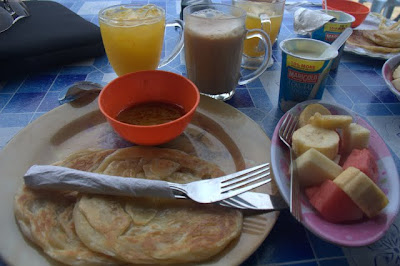
Our most favorite meal in Malaysia - roti canai. Much different than the roti in India or Thailand, this roti is more fluffy and slightly sweet. Malays eat it for breakfast dipped in a spicy curry sauce.

Chicken paprik from Eawan's Restaurant, which was in rain-avoiding sprinting distance from our chalet in the back of Shari-la's resort. Good thing, too, because Eawan is super friendly and his food is tasty.

We stayed at Coral Bay mostly for its great sunsets, which disappointingly never came out in full force during our stay. Dinner on the beach was still enjoyable.

Gorgeous. (But also really rough, which necessitated us trekking up over the hill - sometimes with our scuba equipment - to board the dive boat from the calmer Coral Bay).
Cameron Highlands
Another highlight of our Malaysia travels was the irresistibly green Cameron Highlands. There are crops all over Cameron Highland’s higher elevations like hydroponic strawberries, but the one the Cameron Highlands is most known for is tea. The green blanket of tea bushes over rolling hills is a beautiful sight. We toured the BOH tea plantation and had a cuppa; chowed down on some tasty Malay and Indian food; and hiked through a mossy forest.

We loved the super cheap Indian/Malay restaurants lined up on the main road. We especially liked these ayom (rice pancake like things dipped in coconut milk).

Nasi Lemak, a Malay specialty. It is rice cooked in coconut milk, topped with a hot chili sauce, egg, sardines and cucumber.
Kuala Lumpur
With 1.4 million people, Kuala Lumpur is Malaysia’s largest city and it is also its capital. By the time we rolled into Kuala Lumpur, we were over Asia and ready for New Zealand. Sorry, KL, I’m sure you’re a great city, but you didn’t immediately engage us and so that was that. While we were there, we checked out Chinatown; went to KLCC Suria, a huge mall; and went to the viewing platform of the Petronas Twin Towers (a bit of a snore especially since they’ve already been topped and we’ve been there, done that).
Four Thai Islands
For 24 days in March, we island hopped our way from Thailand to Malaysia, criss-crossing the mainland twice to go from the Gulf of Thailand over to the Andaman Sea and back over to the South China Sea. There was a stretch of 12 straight days where we didn’t hit the mainland, not even to cross the border, moving between islands by ferries of various sizes and shapes. We hit four islands during the Thailand portion: Ko Tao, Ko Phi Phi, Ko Lanta, and Ko Lipe. We had been looking forward to lazy days, and for that, the Thai islands didn’t disappoint, which is why I am able to sum up our two weeks in one post. We had next to zero cultural interactions, and there’s only so many ways to describe our beach bum lives. We visited the islands during the high season and found ourselves surrounded by tourists. Unfortunately, all too many of them were of the young, partying variety, the types to walk around shirtless or hanging out of a bikini hooting and hollering in a rather conservative (and in some of the islands, Muslim) society. The tourism industry is all too eager to cater to these tourists, with shoddily constructed cheap construction tacked up haphazardly next to sewage and water pipes jutting out of the ground, tourist agencies and shops selling the same crap, and most annoyingly, pounding bass music at night. I didn’t expect to be the only ones around, but finding decent accommodation in a quiet location became the bane of our existence. Everything on the islands is more expensive than the mainland and food and accommodation is not nearly as good. But we managed to find some good stuff, we just had to look a little harder. Plus it’s hard to be cranky when the water’s warm and crystal clear, the sand is white and fine, and the sun is shining. Here’s our take (and photos, of course) from the four islands we visited:
Ko Tao
Despite spending 5 nights on Ko Tao, I couldn’t tell you a thing about the island other than it’s great at churning out certified scuba divers at dirt cheap prices. We went there with a one track mind and left after successfully getting our PADI Open Water scuba certification from Buddha View Divers for about $325 a person. Other than that, we saw diddly squat. While we could have made more of an effort to explore, we felt lazy after days spent doing homework for our class and mastering new skills out in the water. So that’s all I have to say about that. (Spoiler alert: we ended up getting our advanced diving certification through Turtle Bay Divers on the Perhentian Islands in Malaysia. More on that later, but if I had to do it over again, I’d probably would have gotten my open water certification through Turtle Bay as well since it was actually cheaper similarly priced [Sean tells me I’m remembering wrong], classes are more intimate and less like a factory, and our instructor Harun was awesome. Nevertheless, the diving schools on Ko Tao get the job done efficiently).
Ko Phi Phi
Ko Phi Phi: definitely winning the award from my least favorite Thai island. You may remember Phi Phi as it was destroyed by the tsunami in 2004. Seven years later, many of the signs of the tsunami are gone, save for new signs displaying the evacuation route. I’m not sure if it was this bad pre-tsunami, but today, it has little charm and it’s crammed full of tourist agencies, trinket shops and clubs. Most people that are there seem to be there to party. In Phi Phi’s defense, we only were there for 2 days and didn’t get a chance to explore beyond the tourist-packed village close to the ferry pier. It rained rather hard while we were there, pinning us in our room and cancelling the boat outing we had planned. And it is a beautiful island, with two crescent shaped bays curving inwards to meet each other. But overall it’s not my cup of tea.
Ko Lanta
Ko Lanta may be the least tropical of the islands we visited, but it probably was my favorite. For starters, it’s bigger than some of the others (but easily circumnavigated in a scooter), meaning that it is less crowded and more spread out. We stayed on Klong Khong Beach on the central western coast, but explored all over the island from the popular Klong Dao Beach in the northwest to the secluded beaches and national park down a dirt road at the southern tip to the less beachy but quaint east coast where the locals live. As we went south in Thailand, the Thai Muslim culture became more predominant, and Muslims operate most of the guesthouses and restaurants on Lanta. The longer we stayed, the more we discovered little hidden gems like Shanti Shanti’s homemade ice creams and sorbets (we tried lime and papaya, chili mango and cinnamon) or Bulan Lanta’s bargain homemade muesli. Our favorite past time on Ko Lanta was sunset watching; there are great sunsets every night up and down Lanta’s long western coast.
Ko Lipe
When you’re daydreaming of escaping to the Thai islands at work, Ko Lipe might be the closest to the picture you have in your mind. Only an hour and half to the Malaysian border by boat and in the middle of a marine reserve, it’s less developed and a little harder to get to than the more northern islands. There’s no pier; the ferry picks up and drops off in the middle of the bay. The water was the bluest and clearest of any of the Thai islands we visited and the sand the whitest and softest. Unfortunately, some of those fabulous beaches can also be strewn with a little too much garbage for my liking. Some people fear Ko Lipe is turning into a mini Ko Phi Phi. Like Ko Phi Phi, motor traffic is prohibited on much of Ko Lipe, and any development that is occurring is shortsighted. It’s also a tad more expensive than even Ko Phi Phi (although we managed to find a decent hut for under $20, albeit without a sink). Hopefully, development won’t run amok, as it is a beautiful gem.






































